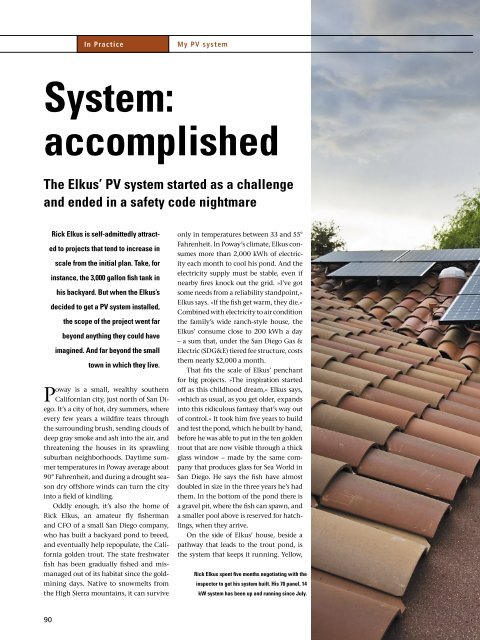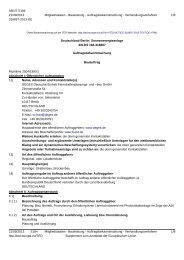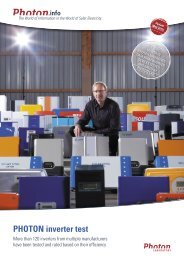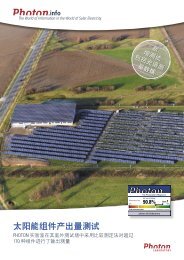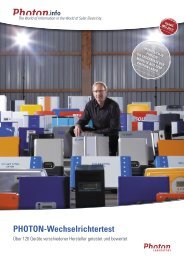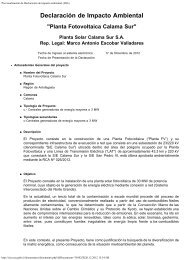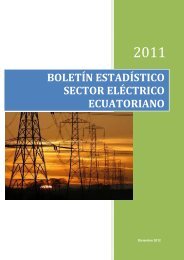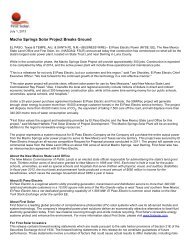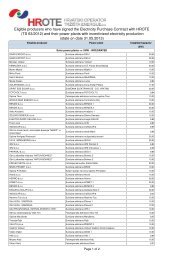INTRODUCTORY SPECIAL INTRODUCTORY ... - PHOTON Info
INTRODUCTORY SPECIAL INTRODUCTORY ... - PHOTON Info
INTRODUCTORY SPECIAL INTRODUCTORY ... - PHOTON Info
Create successful ePaper yourself
Turn your PDF publications into a flip-book with our unique Google optimized e-Paper software.
90<br />
In Practice<br />
System:<br />
accomplished<br />
The Elkus’ PV system started as a challenge<br />
and ended in a safety code nightmare<br />
Rick Elkus is self-admittedly attract-<br />
ed to projects that tend to increase in<br />
scale from the initial plan. Take, for<br />
instance, the 3,000 gallon fish tank in<br />
his backyard. But when the Elkus’s<br />
decided to get a PV system installed,<br />
the scope of the project went far<br />
beyond anything they could have<br />
imagined. And far beyond the small<br />
town in which they live.<br />
Poway is a small, wealthy southern<br />
Californian city, just north of San Diego.<br />
It’s a city of hot, dry summers, where<br />
every few years a wildfire tears through<br />
the surrounding brush, sending clouds of<br />
deep gray smoke and ash into the air, and<br />
threatening the houses in its sprawling<br />
suburban neighborhoods. Daytime sum-<br />
mer temperatures in Poway average about<br />
90° Fahrenheit, and during a drought sea-<br />
son dry offshore winds can turn the city<br />
into a field of kindling.<br />
Oddly enough, it’s also the home of<br />
Rick Elkus, an amateur fly fisherman<br />
and CFO of a small San Diego company,<br />
who has built a backyard pond to breed,<br />
and eventually help repopulate, the Cali-<br />
fornia golden trout. The state freshwater<br />
fish has been gradually fished and mis-<br />
managed out of its habitat since the gold-<br />
mining days. Native to snowmelts from<br />
the High Sierra mountains, it can survive<br />
My PV system<br />
only in temperatures between 33 and 55°<br />
Fahrenheit. In Poway’s climate, Elkus con-<br />
sumes more than 2,000 kWh of electric-<br />
ity each month to cool his pond. And the<br />
electricity supply must be stable, even if<br />
nearby fires knock out the grid. »I’ve got<br />
some needs from a reliability standpoint,«<br />
Elkus says. »If the fish get warm, they die.«<br />
Combined with electricity to air condition<br />
the family’s wide ranch-style house, the<br />
Elkus’ consume close to 200 kWh a day<br />
– a sum that, under the San Diego Gas &<br />
Electric (SDG&E) tiered fee structure, costs<br />
them nearly $2,000 a month.<br />
That fits the scale of Elkus’ penchant<br />
for big projects. »The inspiration started<br />
off as this childhood dream,« Elkus says,<br />
»which as usual, as you get older, expands<br />
into this ridiculous fantasy that’s way out<br />
of control.« It took him five years to build<br />
and test the pond, which he built by hand,<br />
before he was able to put in the ten golden<br />
trout that are now visible through a thick<br />
glass window – made by the same com-<br />
pany that produces glass for Sea World in<br />
San Diego. He says the fish have almost<br />
doubled in size in the three years he’s had<br />
them. In the bottom of the pond there is<br />
a gravel pit, where the fish can spawn, and<br />
a smaller pool above is reserved for hatch-<br />
lings, when they arrive.<br />
On the side of Elkus’ house, beside a<br />
pathway that leads to the trout pond, is<br />
the system that keeps it running. Yellow,<br />
Rick Elkus spent five months negotiating with the<br />
inspector to get his system built. His 70 panel, 14<br />
kW system has been up and running since July.<br />
November 2009


